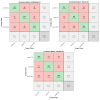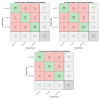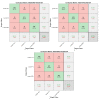Hybrid Models Based on Fusion Features of a CNN and Handcrafted Features for Accurate Histopathological Image Analysis for Diagnosing Malignant Lymphomas
- PMID: 37443652
- PMCID: PMC10341222
- DOI: 10.3390/diagnostics13132258
Hybrid Models Based on Fusion Features of a CNN and Handcrafted Features for Accurate Histopathological Image Analysis for Diagnosing Malignant Lymphomas
Abstract
Malignant lymphoma is one of the most severe types of disease that leads to death as a result of exposure of lymphocytes to malignant tumors. The transformation of cells from indolent B-cell lymphoma to B-cell lymphoma (DBCL) is life-threatening. Biopsies taken from the patient are the gold standard for lymphoma analysis. Glass slides under a microscope are converted into whole slide images (WSI) to be analyzed by AI techniques through biomedical image processing. Because of the multiplicity of types of malignant lymphomas, manual diagnosis by pathologists is difficult, tedious, and subject to disagreement among physicians. The importance of artificial intelligence (AI) in the early diagnosis of malignant lymphoma is significant and has revolutionized the field of oncology. The use of AI in the early diagnosis of malignant lymphoma offers numerous benefits, including improved accuracy, faster diagnosis, and risk stratification. This study developed several strategies based on hybrid systems to analyze histopathological images of malignant lymphomas. For all proposed models, the images and extraction of malignant lymphocytes were optimized by the gradient vector flow (GVF) algorithm. The first strategy for diagnosing malignant lymphoma images relied on a hybrid system between three types of deep learning (DL) networks, XGBoost algorithms, and decision tree (DT) algorithms based on the GVF algorithm. The second strategy for diagnosing malignant lymphoma images was based on fusing the features of the MobileNet-VGG16, VGG16-AlexNet, and MobileNet-AlexNet models and classifying them by XGBoost and DT algorithms based on the ant colony optimization (ACO) algorithm. The color, shape, and texture features, which are called handcrafted features, were extracted by four traditional feature extraction algorithms. Because of the similarity in the biological characteristics of early-stage malignant lymphomas, the features of the fused MobileNet-VGG16, VGG16-AlexNet, and MobileNet-AlexNet models were combined with the handcrafted features and classified by the XGBoost and DT algorithms based on the ACO algorithm. We concluded that the performance of the two networks XGBoost and DT, with fused features between DL networks and handcrafted, achieved the best performance. The XGBoost network based on the fused features of MobileNet-VGG16 and handcrafted features resulted in an AUC of 99.43%, accuracy of 99.8%, precision of 99.77%, sensitivity of 99.7%, and specificity of 99.8%. This highlights the significant role of AI in the early diagnosis of malignant lymphoma, offering improved accuracy, expedited diagnosis, and enhanced risk stratification. This study highlights leveraging AI techniques and biomedical image processing; the analysis of whole slide images (WSI) converted from biopsies allows for improved accuracy, faster diagnosis, and risk stratification. The developed strategies based on hybrid systems, combining deep learning networks, XGBoost and decision tree algorithms, demonstrated promising results in diagnosing malignant lymphoma images. Furthermore, the fusion of handcrafted features with features extracted from DL networks enhanced the performance of the classification models.
Keywords: ACO; DT; GVF; XGBoost; deep learning; fusion features; malignant lymphoma.
Conflict of interest statement
The authors declare no conflict of interest.
Figures











Similar articles
-
Enhancing early detection of Alzheimer's disease through hybrid models based on feature fusion of multi-CNN and handcrafted features.Sci Rep. 2024 Dec 28;14(1):31203. doi: 10.1038/s41598-024-82544-y. Sci Rep. 2024. PMID: 39732953 Free PMC article.
-
Analysis of WSI Images by Hybrid Systems with Fusion Features for Early Diagnosis of Cervical Cancer.Diagnostics (Basel). 2023 Jul 31;13(15):2538. doi: 10.3390/diagnostics13152538. Diagnostics (Basel). 2023. PMID: 37568901 Free PMC article.
-
Hybrid Models for Endoscopy Image Analysis for Early Detection of Gastrointestinal Diseases Based on Fused Features.Diagnostics (Basel). 2023 May 16;13(10):1758. doi: 10.3390/diagnostics13101758. Diagnostics (Basel). 2023. PMID: 37238241 Free PMC article.
-
Evaluation of artificial intelligence techniques in disease diagnosis and prediction.Discov Artif Intell. 2023;3(1):5. doi: 10.1007/s44163-023-00049-5. Epub 2023 Jan 30. Discov Artif Intell. 2023. PMID: 40478140 Free PMC article. Review.
-
Applications of discriminative and deep learning feature extraction methods for whole slide image analysis: A survey.J Pathol Inform. 2023 Sep 14;14:100335. doi: 10.1016/j.jpi.2023.100335. eCollection 2023. J Pathol Inform. 2023. PMID: 37928897 Free PMC article. Review.
Cited by
-
Artificial Intelligence in Lymphoma Histopathology: Systematic Review.J Med Internet Res. 2025 Feb 14;27:e62851. doi: 10.2196/62851. J Med Internet Res. 2025. PMID: 39951716 Free PMC article.
-
PrecisionLymphoNet: Advancing Malignant Lymphoma Diagnosis via Ensemble Transfer Learning with CNNs.Diagnostics (Basel). 2024 Feb 21;14(5):469. doi: 10.3390/diagnostics14050469. Diagnostics (Basel). 2024. PMID: 38472941 Free PMC article.
-
Enhanced HoVerNet Optimization for Precise Nuclei Segmentation in Diffuse Large B-Cell Lymphoma.Diagnostics (Basel). 2025 Aug 4;15(15):1958. doi: 10.3390/diagnostics15151958. Diagnostics (Basel). 2025. PMID: 40804921 Free PMC article.
-
The Bayesian mixture expert recognition model for tobacco leaf curing stages based on feature fusion.Plant Methods. 2025 Jun 16;21(1):86. doi: 10.1186/s13007-025-01384-7. Plant Methods. 2025. PMID: 40524222 Free PMC article.
-
A novel hybrid convolutional and transformer network for lymphoma classification.Sci Rep. 2025 Jul 19;15(1):26259. doi: 10.1038/s41598-025-11277-3. Sci Rep. 2025. PMID: 40683974 Free PMC article.
References
-
- Kobayashi H., Asada N., Egusa Y., Ikeda T., Sakamoto M., Abe M., Maeda Y. Transformation to diffuse large B-cell lymphoma with germinal center B-cell like subtype and discordant light chain expression in a patient with Waldenström macroglobulinemia/lymphoplasmacytic lymphoma. Int. J. Hematol. 2021;114:401–407. doi: 10.1007/s12185-021-03157-z. - DOI - PubMed
-
- Zmigrodzka M., Witkowska-Pilaszewicz O., Pingwara R., Pawlak A., Winnicka A. Canine B Cell Lymphoma- and Leukemia-Derived Extracellular Vesicles Moderate Differentiation and Cytokine Production of T and B Cells In Vitro. Int. J. Mol. Sci. 2022;23:9831. doi: 10.3390/ijms23179831. - DOI - PMC - PubMed
-
- Kanas G., Ge W., Quek R.G., Keeven K., Nersesyan K., Arnason J.E. Epidemiology of diffuse large B-cell lymphoma (DLBCL) and follicular lymphoma (FL) in the United States and Western Europe: Population-level projections for 2020–2025. Leuk. Lymphoma. 2022;63:54–63. doi: 10.1080/10428194.2021.1975188. - DOI - PubMed
-
- King R.L., Gupta A., Kurtin P.J., Ding W., Call T.G., Rabe K.G., Parikh S.A. Chronic lymphocytic leukemia (CLL) with Reed–Sternberg-like cells vs. Classic Hodgkin lymphoma transformation of CLL: Does this distinction matter? Blood Cancer J. 2022;12:18. doi: 10.1038/s41408-022-00616-6. - DOI - PMC - PubMed
Grants and funding
LinkOut - more resources
Full Text Sources
Other Literature Sources

